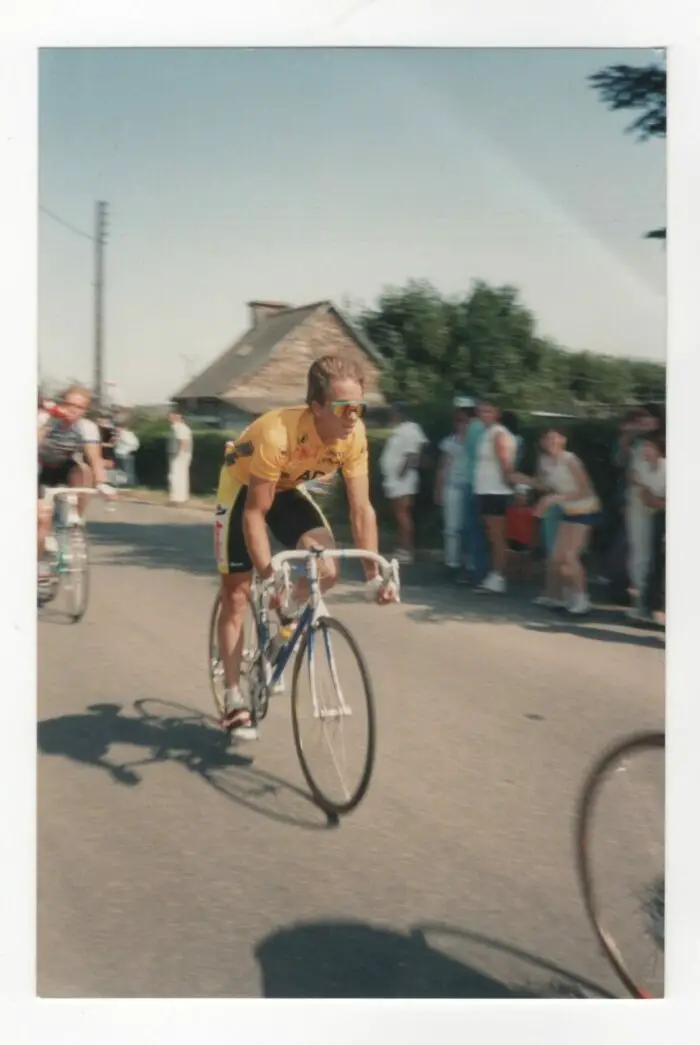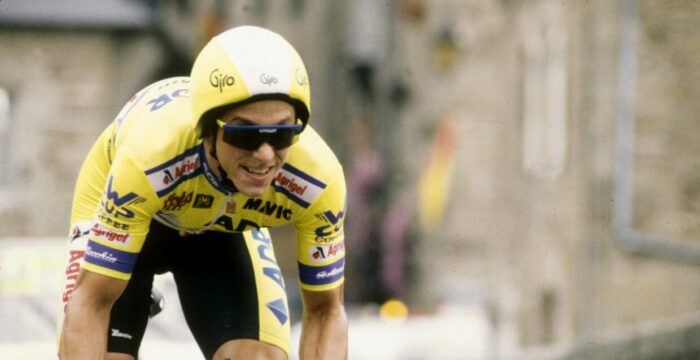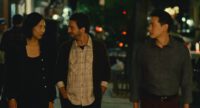The American racer Greg LeMond is now subject of not one but two epic cycling documentaries. In 2014, Slaying the Badger took aim at what became a heated rivalry between the (then) young American and his French mentor-friend-coach-teammate Bernard Hinault, a fierce competitor nicknamed “The Badger,” as they challenged for the coveted yellow jersey at the 1986 Tour de France. Directed by John Dower from Richard Moore’s equally excellent book, that film is as good as sports documentary gets, a probing, pulsing recounting of friendship and betrayal over 200 miles across the plains and mountains of France. In 1989, three years later—after a freak accident slowed the speedy LeMond to a crawl—the American challenged once again for the race title under epic circumstances. And The Last Rider, with a similar cast but different story to tell, is every bit up to the challenge laid down by Slaying the Badger.
The 1986 race recounted in Slaying the Badger saw Hinault, “The Badger,” the reigning and five-time Tour de France champion, who had benefited from young LeMond’s assistance the prior year, promising it was LeMond’s turn. Suave and gracious on camera, cutthroat on wheels, Hinault had drafted the young American to his team as a domestique, the riders there to support the star, but LeMond quickly proved himself Hinault’s equal—and hence, rival. European teams are set up to support a single rider’s best effort to win the race, but the La Vie Claire team for which Hinault and LeMond rode would prove a competition unto itself as Hinault broke his vow, attacked LeMond on the climbs, and did all he could to prevent his teammate from victory.
Remarkably, LeMond was undaunted, and held off Hinault’s challenge and betrayal to win his first Tour de France, the first American to do so, signaling an epic shift from the old leather-bound guard of European domination to a newly international galaxy of individual stars. Where Slaying the Badger leaves off, The Last Rider—though unrelated in every way to that other LeMond documentary except for its subject—picks up, focusing its story on LeMond’s subsequent and equal-if-not-greater battle a few years later.

The Last Rider too charts LeMond’s boyhood in Nevada, his accidentally falling into recreational, then competitive cycling, his remarkable gift for the sport almost immediately apparent as he and his father dashed up and down the Sierra Nevada, his then-undiagnosed ADHD finding an outlet in the solace of cycling. What Slaying the Badger did not address was LeMond’s sexual abuse at the hands of a relative, a traumatic, ongoing experience that took years for the cyclist to acknowledge publicly and address. (LeMond is now an advocate for male victims of child sex abuse.)
The Last Rider is more focused on the impact of that trauma and a second on LeMond’s life and career. Not long after his remarkable 1986 Tour de France win, hoping to defend his title, LeMond suffered a wrist injury and returned to America to recuperate. There he would face worse: while hunting he was accidentally shot by his brother-in-law, 60 pellets through his side, losing 65 percent of his blood volume, and in recovery after two surgeries, 25 pounds of muscle mass. Somehow, he would return, but when he did, he learned his Dutch PDM team was on the then-nascent doping bandwagon, and left them for the unheralded Belgian ADR group.
During this comeback, any accomplishment at all would be significant. When he eventually returned in 1988, his first attempt was aborted after overtraining resulted in injury. In 1989, LeMond was content simply to ride, maybe to finish, hardly to place, and certainly not to win. Besides that, the Tour’s two favorites—defending champion Pedro Delgado and two-time Tour winner Laurent Fignon, LeMond’s former teammate during Hinault’s wins—were formidable competitors. Delgado missed his start time and was penalized in the prologue individual time trial, leaving Fignon—his long blond ponytail covering his sharply receding hairline and prominent brow, a sulky, harsh competitor with no love for the media or the public—as the resounding favorite. No one, including LeMond himself, gave the American any chance.
To nearly everyone’s surprise, the 1989 Tour de France would become, arguably, the greatest race and the most closely contested in its history, even perhaps one of the greatest sporting events of all time. Inexplicably, LeMond kept pace with the intimidating Fignon, surprising himself at every stage with his renewed fitness and vigor, somehow finishing the penultimate stage within striking distance of Fignon as the two descended upon the Champs-Élysées with the Frenchman enjoying what was thought to be a nearly insurmountable 50-second lead. LeMond took to the final day with several technological innovations: aerobar handles, a teardrop helmet, and a single rear disc wheel, while Fignon went with no helmet, his ponytail flapping in the breeze, regular handles, and two disc wheels, making him vulnerable to cross winds. Not to mention a case of saddle sores that swelled one of his testicles to three times its normal size.

It would be a final stage that would define the Tour and change the sport forever. Like Slaying the Badger, The Last Rider makes a known outcome into a suspenseful contest, alternating archival footage from the race with explainers, interviews with LeMond, his wife Kathy, Hinault, Delgado, and others (sadly Fignon, to whom the film is dedicated, died in 2010). There is overlap between the two films—both chart, if briefly, LeMond’s youth and adolescence and later marriage to Kathy, as well as his camaraderie with Hinault—but if anyone deserves the limelight of two excellent documentaries examining his two greatest achievements, it is the redoubtable LeMond, who has triumphed over adversity more than once in his life.
Even better, for a sport so racked by controversy in recent decades, The Last Rider functions as something of an antidote to the stories of Lance Armstrong, Floyd Landis, and their doping. It, unlike theirs, is story of resilience in the face of adversity, of a champion willing himself to compete after life-threatening injury, and of sport’s greatest contest in what was its single greatest iteration. For fans of the sport, there’s no shortage of excellent documentary content in this month’s leadup to the 2023 Tour de France: you can still check out Slaying the Badger on ESPN’s 30 for 30 series, look forward to The Last Rider as it hits theaters this week, the also-excellent new documentary Enter the Slipstream or the Netflix docuseries Tour de France: Unchained.
Even among that excellent competition, The Last Rider offers a thoughtful, pensive, revelatory behind-the-scenes look at one of the sport’s—one of sport’s—great stories.
Roadside Attractions will release THE LAST RIDER in theaters on June 23rd, 2023.




